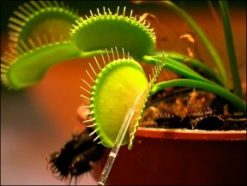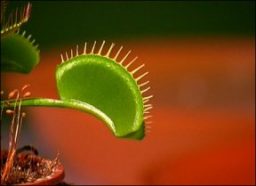How a Venus Flytrap Snaps Shut
A Venus flytrap stores energy to allow its hinged leaves to snap shut quickly.
By Emily Sohn
The blink-of-an-eye closing of a Venus flytrap’s leaf on a hapless fly is one of the fastest movements in the plant kingdom. Now, after more than a century of wondering how these flesh-eating plants do it, scientists have come up with a possible explanation.
The secret isn’t muscle; it’s geometry. The shape and structure of a Venus flytrap’s leaf allows it to snap up juicy insect morsels in just a tenth of a second, say researchers from Harvard University, Rockefeller University, and the University of Provence.
 |
|
Tickling the inner surfaces of an open Venus flytrap leaf causes the leaf to snap shut. |
| Yoël Forterre, et al./Nature |
Lots of plants move, but their movements are usually very slow. It can take days for flower buds to open and hours for leaves to respond to sunlight. Flytraps snap shut much more rapidly.
Mathematician Lakshminarayanan Mahadevan had long wondered how flytraps are able to react so quickly. Then, a researcher he works with gave him one of the plants for his office, and he decided to find out what’s going on.
Mahadevan and his colleagues painted fluorescent dots on the curved leaves of a group of flytraps and measured the leaves using a microscope. The researchers also took high-speed videos of the plants in action.
The pictures and measurements showed what happens after an insect or some other object lands on a leaf and triggers it. First, cells on the outside surface of the plant’s leaves get longer, while cells on the inside surface don’t change. This makes the leaves want to curl inward. The oppositely curved shape of an open leaf, however, causes it to resist the inward push.
The team’s measurements showed that pressure builds up for about a second, until the leaf can’t take it anymore. Then, the leaf takes just a fraction of a second to snap shut.
 |
|
A Venus flytrap’s leaf can close in just a tenth of a second. |
| Yoël Forterre, et al./Nature |
Scientists suspect that the same mechanism may trigger rapid motion in other plants. Engineers could also try taking advantage of this effect when they’re designing new sensors, valves, or other devices.—E. Sohn
Going Deeper:
Weiss, Peter. 2005. In a snap: Leaf geometry drives Venus flytrap’s bite. Science News 167(Jan. 29):69. Available at http://www.sciencenews.org/articles/20050129/fob5.asp .
You can learn more about the Venus flytrap’s bite at www.news.harvard.edu/gazette/daily/2005/01/26-flytrap.html (Harvard University).







